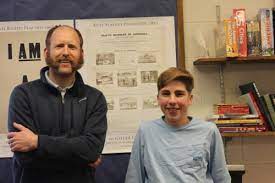A veteran middle school teacher, Luke has championed YA literature in his U.S. History class by incorporating Laurie Halse Anderson’s Chains; he has also received recognition for his ability to have truthful and relevant discussions regarding events such as the riots at the U.S. Capitol. He is additionally known for an annual Civil War general beard contest, and his students got the better of him [by adding hairstyles, too] in 2019.
Given that Luke’s course is only one semester, teaching Stamped poses different challenges to students that meet the text with different knowledge, though the text is valuable whether it’s taught the first or second semester. This highly-acclaimed, high interest text moves students into a grounded present by providing a history of systemic racism from the very beginning to today. Luke’s first semester students have pre-Civil War knowledge: here are students wrestling with the implications of founding a nation whose wealth is contingent upon slave labor. They know about the documents that served to found our nation as well as the compromises that took place (including the three-fifths compromise), and that even then, there were groups of people who recognized early on that owning another human being was morally reprehensible. When students read Stamped during the first semester, they have had opportunities to reflect about how the U.S. was being led to Civil War. In this way, Stamped broadens students’ reflection on whether our nation’s habits have truly changed.
Luke’s second semester students have more context: these students have all of the above knowledge plus post-Civil War awareness. They know about post-reconstruction and its failures. They are considering the implications of the bloodiest war ever fought by the United States and the idea that within 10 years of the Civil War, many of the things the war was supposed to decide had been reversed. For example, though people understood that slavery would be abolished as a result of the Civil War, many inequalities persisted with Jim Crow laws and voting restrictions. Second semester students have also recently completed a unit on democratic discourse provided by the Language Arts department, which further scaffolds Luke’s efforts for respectful dialogue.
- a brief Google slide show that walks students through what they can expect from the book
- reading Kendi’s “Dear Reader” section
- students responding in writing to key questions: What are the consequences of keeping racism/anti-racism out of public view? What does this mean for you? What kind of thinking might you undertake, what kind of discussion might you have, what kind of actions might you take?
- emphasizing Kendi’s acknowledgment of our racist past and racist present: “The first step to building an antiracist America is acknowledging America’s racist past. By acknowledging America’s racist past, we acknowledge America’s racist present. In acknowledging America’s racist present, we can work toward building an antiracist America” (p. xv)
- adding film in order to bring more understanding: Viewing and discussing Learning for Justice’s 40-minute documentary Selma: The Bridge to the Ballot and the 2014 film Selma.
- a picture book read-aloud, and discussion, of Sandra Neil Wallace and Rich Wallace’s The Teachers March!: How Selma’s Teachers Changed History
- having students reflect on a series of writing prompts each day, guided by the topic of the current chapter. In these reflections, students have opportunities to consider not only the history of racism, but of the racist way that history has been reported. Students are consistently asked: Where do you see yourself in this timeline?
- culminating projects in which students map W.E.B. DuBois’s journey from assimilationist to anti-racist. Students translate Kendi’s accounting of this journey to a flowchart that shows changes that took place and which individuals were responsible for DuBois’s shifts in thinking. This activity allows students to consider the ways in which people’s minds can be changed, and how they can work toward change as well.
- the “I used to think, now I think” reflection from thinking pathways, a metacognitive activity in which students detail how their worldview has changed as a result of the reading. Variations of past responses include:
- the most common: “I HAD NO IDEA THIS EVER TOOK PLACE.” Many students think that the Civil War solved slavery and anti-equality problems. Reading and reflecting on Stamped helps students learn about the dark 100+ years that have followed the war and how many historical figures--those who students thought were anti-racist advocates--were actually apathetic, inconsistent, and/or racist.
- the realization that we have a problem: “I used to think that the issue was being overstated/Now I’m able to see the the problem is even worse then what the media or anybody says.”
- the recognition that things can change: “I used to think that there is no more change to do/Now I think many things can be changed and many things can be made better.”
Beyond the culminating activities and reflections, students can be encouraged to look critically at, and discuss, current events. After reading news articles, students can analyze where this particular event, and its players, fit into the book (how is what is happening aligning with what’s happened before? how is it different? who is advocating for justice in this story?) Students can also research current events and augment the timeline shared in the book, identifying the assimilations/segregationist/antiracists, and those that may fall into each of these categories during their journey.
Each time we teach--no matter what the text-- we can return to students’ original questions: What are the consequences of keeping racism/anti-racism out of public view? What does this mean for you? What kind of thinking might you undertake, what kind of discussion might you have, what kind of actions might you take? May each of us see the power and promise of young adult literature as we continue to learn, take responsibility, and advocate for justice.








 RSS Feed
RSS Feed